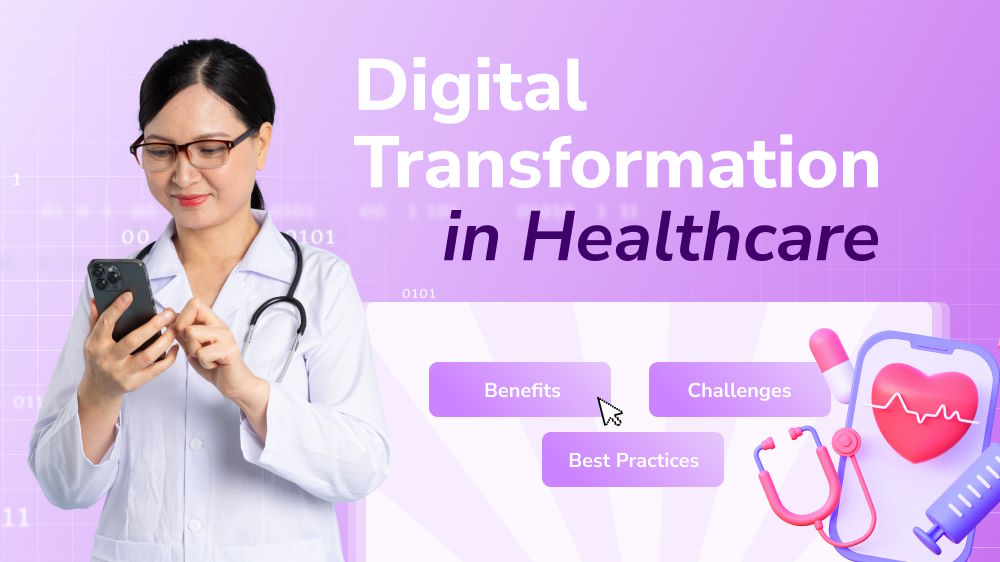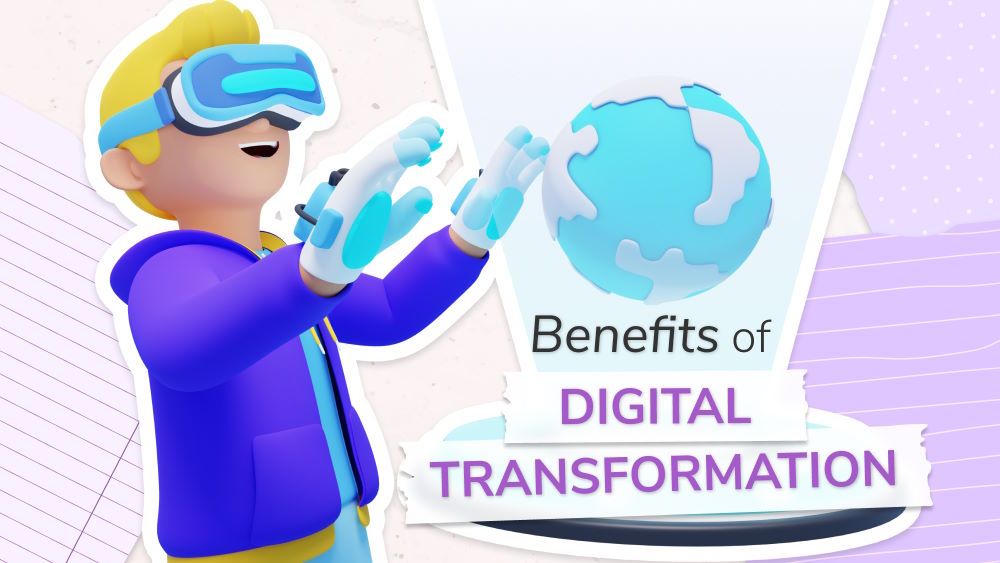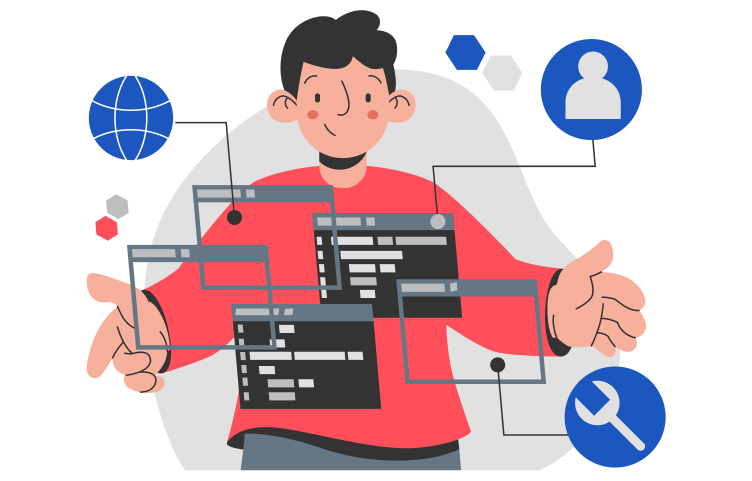The Future-Shaping Technologies for Digital Transformation

Content Map
More chaptersDisruptions during the pandemic, Russia - Ukrainian war, and the current economic recession have forced companies to look for ways to strengthen their business resilience, i.e., by outsourcing software development teams to work on custom software or replacing legacy systems with cloud computing technologies or SaaS. Many actions are being taken, but one thing is common: Digital transformation in businesses.
There are many aspects to talk about when it comes to this subject. In this article, however, we are looking into the technologies for digital transformation - the digital technology that might very well shape the operation of enterprises in the near future.
Technologies Enable Digital Transformation
Digital transformation technologies, as complicated as they may sound, are actually more present and prominent in business processes than you think. Below are the technologies that have the ability to define the future.
Artificial Intelligence (AI) and Machine Learning (ML)
You have probably heard of Artificial Intelligence and Machine Learning and how it has the potential to redefine the labor workforce. Impressive results generated by artificial intelligence chatbots such as ChatGPT by Open AI, Google’s Bard, or interesting answers by Microsoft’s Bing have caught international attention. It is arguably one of the most debated digital technologies these days.
Surely, as one of the most innovative technologies out there, AI and ML don’t simply answer questions or gather information. The use of AI and ML can be found in almost every sector:
- AI in Entertainment: Netflix or Spotify users are probably used to the recommendations of new movies, shows, or songs. This is achieved with the help of AI and ML algorithms.
- AI in Social Media: Twitter, Facebook, or TikTok use the massive data from their users to effectively analyze and work on algorithms that automatically suggest hashtags or trends that will catch the users’ attention.
- AI in Manufacture: AI/ ML has long been used to automate assembly lines, significantly reducing any human errors or downtime.
- AI in Healthcare: The technology has long been used to build sophisticated machines to detect disease, identify cancer cells, and use data analysis to produce an early diagnosis.
- And the list goes on. AI is also present in software development, education, agriculture, gaming, finance, astronomy, navigation, etc.
The technology automates repetitive and mundane tasks with high accuracy, stores and analyzes mountains of data and provides businesses with data-based insights, and delivers positive digital experiences for customers.
At the time this article is written, a new AI/ML-related technology is probably being developed. It should not come as a surprise as it has a latent potential and myriad benefits. If you have thought about incorporating AI and ML into your business strategy but have not yet known how to go about it, now is the time to do it.
Internet of Things (IoT)
Do you have a smartwatch, a smart TV, or any other sort of smart appliance? If the answer is yes, you are a part of the vast Internet of Things (IoT) network.
The Internet of Things is a large system of devices, sensors, or machines connected to the Internet. It ranges from smart devices like the smartwatch used to track your fitness, sensors on trucks that track their location in real-time, to devices that track a patient’s heartbeat. It is both convenient for daily life usage and, more so, enhances many aspects of any business operation. All the data from them are then collected automatically and discarded safely when needed.
As you can already imagine, raw data generated from IoT devices are massive. When managed and analyzed properly, such data would play a large role in business innovation. After all, in this day and age, information and data is a valuable asset.
Mobile Technology
Did you know that it consumes an average of 3 hours and 15 minutes of our time on our phones each day?
Mobile phones and other kinds of smart devices have become so ubiquitous that many can’t even recall the days before this technology came into their lives. Smartphones and tablets have enabled users to do almost anything they need on their small, hand-held devices. The device and technology go where you go, and it has long gone beyond calling and receiving calls.
If you need to work, you can just whip out your phone and send and receive emails, download files, and even make adjustments to them. If you need to remind yourself to take care of your health, drink more water, and take your medication - there are apps that take care of it for you. Need some entertainment? Social media, mobile games, and streaming services all have you covered.
Therefore, to ensure their online presence, companies cannot skip mobile-friendly interfaces. Make mobile technology one of the priorities of your digital transformation strategy.
Big Data
Big data is, as the name suggests, big. It contains terabytes to zettabytes of structured, semi-structured, or unstructured data. Big data is gathered as a result of the Internet of Things, telecommunications, website trackers, social media, and any other location where customers or other systems interact with your company.
The complex data collected can be a challenge for traditional systems to analyze. This is where big data analytics comes in to help you identify patterns, discover unknown correlations, market trends, and forecasting. Big data has been around for a while, so it undoubtedly delivers beneficial results for your enterprise. The way the data is handled, however, is changing with the use of AI and ML.
Overall, how you handle raw data processing is a critical factor in a successful digital transformation.
Robotic Process Automation (RPA)
Thanks to digital transformation, long gone are the days of boring, repetitive tasks requiring the attention of humans. Have Robotic Process Automation, or RPA, take care of them.
AI and machine learning (ML) have led to the development of robotic process automation. But unlike AI, an RPA is more sophisticated, and it is trained to interact with people the way that humans do. It often takes care of tasks such as auditing data, migrating data, maintaining invoices, inquiring processing, etc., with a high rate of accuracy. At a higher level, this technology may even completely restructure the workflow to make operations more efficient. Additionally, since it doesn’t need a break every now and then, it has the ability to handle large volumes of workload each day with consistency.
3D Printing
Among the many digital transformation initiatives, a technology worth noting is 3D printing. Not only is the process of printing the product fascinating, but it is also extremely beneficial.
Unlike traditional manufacturing, 3D printing doesn’t need you to produce in bulk to be cost-effective. Therefore, if you want to quickly test a few prototypes, the technology has got you covered. You can almost design anything with 3D printing - this opens up huge potential for innovative designs in the future. This also means less dependency on a third-party vendor. Another huge plus of this technology is it produces very little waste - the materials used in 3D printing can be reused quickly and easily.
Digital Twin
Digital Twin, quite literally, creates a digital clone of physical models, such as people, places, systems, and processes in the real world.
The digital duplicate is then put through simulations to gather information and make predictions based on the gathered data. When combined with other digital transformation technologies like IoT, AI, and big data, digital twins drive innovation. The collected data from the digital duplicate is then used to make improvements to its real-world version.
Digital twins have been useful in many sectors. For example, in healthcare, practitioners can replicate treatments and specific circumstances before attempting them in real life thanks to digital twins of patients or their organs. Manufacturing is another example. Using digital systems and sensors, manufacturers manage to pinpoint where energy wastes might be happening and make suitable adjustments.
Extended Reality (XR)
In the simplest terms, augmented reality (AR), virtual reality (VR), mixed reality (MR), and all other forms of reality are collectively referred to as Extended Reality (XR). To briefly explain these terms:
- Virtual reality (VR) is a 3D environment with the use of specialized headsets, haptic touch, and even environmental input. It allows users to become entirely immersed in simulated realities.
- Augmented reality (AR) overlays images into the real world rather than creating an entirely new environment.
- Mixed reality (MR) is a hybrid of virtual and augmented reality. Using this technology, complex landscapes with real-time interaction between physical and digital components are created by fusing the actual and virtual worlds.
XR allows people to visit a virtual world and have immersive experiences that come close to that in the physical world. The idea of Metaverse relies on such experience. Even Apple has recently introduced an augmented and virtual reality headset, forecasting the future importance of this technology, as it offers innovative ways of entertainment, engaging customers, and training and development.
Tips for Successfully Using Technologies for Digital Transformation

The top technologies for digital transformation have the power to transform any business. They prompt any business leader to rethink their business strategies, and that alone can cause a lot of stress.
Do remember that each and every business is unique, and there is no one-size-fits-all digital solution. Talk to your team before any major decisions, look for the right partner, or consult seasoned experts to enable digital transformation at its full potential. The economic climate has become ultra-competitive, so make wise choices to remain competitive.
Nonetheless, below are some rules of thumb you should follow before diving headfirst into any digital transformation initiative.
Start with Evaluating Your Situation
You might already have a desired outcome in mind, and that is a good thing. However, work backward from there and take into account the current state of your business: How are people currently working? What does security look like at the moment? How do you ensure compliance? With a clear understanding of your current business in mind, there will be a higher chance of the digital transformation being sustainable and a long-term success.
Find the Right People
Have people with domain experience work for you. Leadership skills are important, indeed, but without the necessary technical knowledge in the industry, it is hard for the plan to be cohesive from the start. Sometimes you will need further consultation from third parties, and make sure to keep track of your budget if you wish to do so.
Work Out an Adoption Plan
A digital transformation always sounds exciting, but it is only considered a success once it is implemented. Empower your teammates by having them participate in the process of adopting the new digital initiative. Also, be ready to address legacy systems and make changes in existing workflows.
Have an Agile Mindset
The success rate of using an agile methodology during transition is very high. You receive feedback from frequent, iterative, consumable releases that are quickly field-tested to determine whether your project plan is still on track.
Technologies for Digital Transformation; Don’t Have to be Scary
Embrace digital transformation technology. It doesn’t always have to go horribly wrong, nor does it always have to be a struggle. Having the right mindset and digital transformation strategies, with the help of the right people and constant connection, will eventually lead you to your desired result - a business operating with cut-edge technology that stays ahead of the game.







